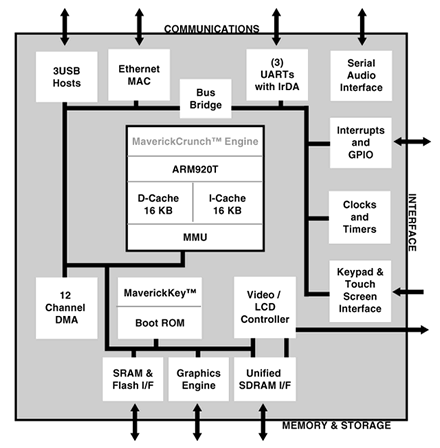Sub $13 SoC includes MMU, LCD controller, sound, LAN, Linux
Oct 13, 2004 — by LinuxDevices Staff — from the LinuxDevices Archive — 5 viewsCirrus Logic is shipping a highly integrated SoC (system-on-chip) for cost-sensitive networked applications such as gaming machines, POS (point-of-sale/service) terminals, home automation systems, and automotive navigation systems. The $13 EP9307 is based on a 200MHz ARM9 core, with integrated graphics, audio, network, and a host of other interface controllers. It comes with Linux.
The EP9307 is the fourth in Cirrus's “9 Series” or “Maverick” product family announced in February, behind the EP9315 and EP9301, launched in February, and the EP9302, launched in May. Cirrus's first ARM 9 chip that supported Linux, the EP9312, was launched in 2000.
The EP9307 is based on an ARM920T core with 16KB each of data and instruction cache, an MMU (memory management unit), and the MaverickCrunch mixed-mode math coprocessor, said to “greatly accelerate single- and double-precision integer and floating-point processing capabilities.”

The 200MHz, $13 EP9307 includes an MMU and supports XGA LCDs
In addition, the EP9307 integrates a 2D graphics accelerator and touchscreen interface supporting LCD sizes up to 1024 x 768 (XGA) resolutions. The serial audio interface supports AC97 audio in “multiple configurations,” according to Cirrus. The company the chip's A/V capabilities will help it serve in POS terminals that double as advertising kiosks, and in self-serve touchscreen terminals. The EP9307 also provides built-in controllers for Ethernet LAN, USB, three serial ports, a keypad/touchscreen interface, and general purpose I/O.
Additional specs include:
- 200 MHz ARM920T processor
- 16 KB data cache and 16 KB instruction cache
- MMU enabling Linux and Windows CE
- 100 MHz system bus
- MaverickCrunch math engine
- Floating point, integer, and signal-processing instructions
- Hardware interlocks for in-line coding
- MaverickKey IDs for digital rights management or design IP security
- 32-bit unique ID
- 128-bit random ID
- Integrated peripheral interfaces
- Graphics accelerator
- Three-port USB 2.0 full-speed host (OHCI)
- Three UARTs (16550 type)
- IrDA interface, slow and fast mode
- LCD interface with dedicated SDRAM channel
- Touchscreen interface
- SPI port
- AC '97 interface
- I²S interface, up to 6 channels
- 8×8 keypad
- External memory options
- 32-bit SDRAM interface, up to 4 banks
- 32-, 16-, and 8-bit SRAM/Flash/ROM I/F
- Serial EEPROM interface
- Internal peripherals
- Real-time clock with software trim
- 12 DMA channels for data transfer that maximizes system performance
- Boot ROM
- Dual PLLs to control all clock domains
- Watchdog timer
- Two general-purpose 16-bit timer
- General-purpose 32-bit timer
- 40-bit debug timer
- General-purpose I/Os (GPIOs)
- 14 enhanced GPIOs including interrupt capability
- 18 additional optional GPIOs multiplexed on peripherals
- Package: 272-pin TFBGA; option for lead-free assembly
John Delfeld, director of embedded products marketing, said, “The EP9307 offers speed and flexibility for demanding embedded applications in which superb graphics handling ability, intelligent user interface, and lower costs are essential.”
Availability
The EP9307 is available in a 272-pin TFBGA package, priced at $12.74 in volumes of 10,000. Cirrus Logic's Nine-Series embedded processor ICs include the EP9301, EP9302, EP9312 and the flagship EP9315.
This article was originally published on LinuxDevices.com and has been donated to the open source community by QuinStreet Inc. Please visit LinuxToday.com for up-to-date news and articles about Linux and open source.